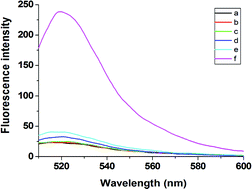A fluorescent aptasensor based on single oligonucleotide-mediated isothermal quadratic amplification and graphene oxide fluorescence quenching for ultrasensitive protein detection†
Abstract
In this work, we have developed a novel fluorescent aptasensor based on single oligonucleotide-mediated isothermal quadratic amplification (SOIQA) and graphene oxide (GO)-mediated fluorescence quenching for the ultrasensitive detection of proteins in a homogeneous solution. The SOIQA consists of a fluorophore-labeled aptamer hairpin probe containing T7 exonuclease (T7 Exo)-resistant 5′-protruding termini and a mismatch base at its 3′-end, DNA polymerase, T7 Exo and GO. The target analyte binds with the aptamer sequences and unfolds the fluorophore-labeled aptamer hairpin probe to form a new DNA hairpin, inducing the catalytic recycling of the target analyte (assisted by DNA polymerase) and DNA sequences (aided by T7 Exo) to achieve SOIQA, which results in the digestion of numerous fluorophore-labeled aptamer hairpin probes and the generation of a large amount of mononucleotides carrying the fluorophore. These mononucleotide products cannot be adsorbed onto the GO, leading to a dramatic increase in the fluorescence intensity for the amplified detection of the target molecules. In the absence of the target analyte, however, the SOIQA reaction is inhibited and the fluorophore-labeled aptamer hairpin probe is adsorbed onto the GO, leading to an extremely low fluorescence background signal. To test the feasibility of the SOIQA systems, a protein cancer marker, carcinoembryonic antigen (CEA) was used as the model analyte. The developed aptasensor could detect CEA with a detection limit of 28.5 fg mL−1 (∼142 aM), high specificity and a broad detection range of 6 orders of magnitude. And this one-step incubation can be completed in 60 min. In addition, the approach uses only one oligonucleotide strand, and is simple. Moreover, this SOIQA sensing method is suitable for rapid and direct quantification of proteins in complex biological samples such as clinical serum. Considering the simplicity and superior sensitivity/specificity, the developed sensing method provides a promising platform for the analysis of a variety of low-abundance biomolecules.



 Please wait while we load your content...
Please wait while we load your content...